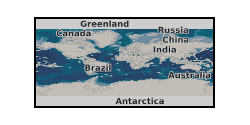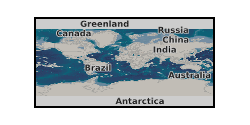Dust
Type of resources
Available actions
Topics
Keywords
Contact for the resource
Provided by
Years
Formats
Representation types
Update frequencies
-
This dataset contains Raman Lidar data from four UK sites in the Met Office Volcanic Ash lidar network for the 15th and 16th October 2017 when ex-hurricane Ophelia passed to the West of the British Isles, bringing dust from the Sahara and smoke from Portuguese forest fires that was observable to the naked eye in the UK. The sites included are Camborne, Rhyl, Watnall, and Loftus. The data files contain profiles for co-polar, cross-polar and Raman backscatter data. The data support the following publication: Osborne, M., Adam, M., Buxmann, J., Sugier, J., Marenco, F., and Haywood, J.: Saharan dust and biomass burning aerosols during ex-hurricane Ophelia: validation of the new UK lidar and sun-photometer network, Atmos. Chem. Phys. Discuss., https://doi.org/10.5194/acp-2018-695.
-
The Icelandic Volcano, Eyjafjallajokull, started erupting on 14th April 2010. The volcanic ash cloud produced covered much of Northern Europe for several weeks causing extensive disruption to air travel. The UK and European atmospheric communities had many instruments - both airborne and ground-based, remote sensing and in-situ - taking measurements of the ash cloud throughout this period. This dataset contains a variety of satellite products including dust and sulphur dioxide (SO2) retrievals.
-

The <250um fraction of 19 household vacuum dust samples (collected by citizen participants during 2019-2021) were extracted using high throughput isolation of microbial genomic DNA and sequenced using Illumina NextSeq (12 samples from a national campaign within the UK, 7 samples from Greece and a negative reagent control included to ensure sterility throughout the processing and sequencing steps). These data are available (following period of embargo) from the European Nucleotide Archive via the individual sample accession numbers ERS9609044 to ERS9609063, submitted under the study ID PRJEB49546. Sample location data are provided at town/city, country level. Given the amount of time people spend indoors, residential environments are perhaps the most important, but understudied environments with respect to human exposure to microbes and other contaminants. Across our urban environments, anthropogenic activities (both current and legacy) provide for multiple sources and pathways for the generation and distribution of microbes, inorganic and organic contaminants within the home environment, yet we know relatively little about the potential for dissemination of antibiotic resistance in microbial communities within indoor dust.
-

The <250um fraction of 28 household vacuum dust samples were extracted using high throughput isolation of microbial genomic DNA (21 samples from a national campaign within the UK and 7 samples from Greece, providing samples from two contrasting bioclimatic zones). Both positive and negative reagent controls were included to ensure sterility throughout the processing and sequencing steps, and a randomly selected sample was run in triplicate (DSUK179). These data (raw fastq files: Target_gene 16S and Target_subfragment V4) are available from the European Nucleotide Archive via the study accession PRJEB46920 with individual sample accession numbers ERX6130460 to ERX6130493; https://www.ebi.ac.uk/ena/browser/view/PRJEB46920). A wide range of anthropogenic factors are likely to affect the indoor microbiome and to capture some of this heterogeneity participants were asked to complete a questionnaire. In addition, trace element data were generated using an X-Ray fluorescence spectrometry on the <250um sieved fraction of the household vacuum dust. Sample location data are provided at town/city, Country level. Indoor dust serves as a reservoir for environmental exposure to microbial communities, many of which are benign, some are beneficial, whilst some exhibit pathogenicity. Whilst non-occupational exposure to a range of trace elements and organic contaminants in house dust are a known risk factor for a range of diseases and poor health outcomes, we know far less about the microbial communities associated with our indoor home environments, and their interaction/impacts on human health. Our knowledge of indoor residential bacterial biodiversity, biogeography and their associated drivers are still poorly understood. The data were collected to improve our understanding of the home microbiome.
 NERC Data Catalogue Service
NERC Data Catalogue Service